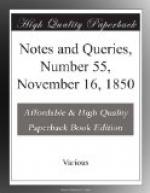R.S. HAWKER.
Morwenstow.
Medal struck by Charles II.—Voltaire, in his Histoire de Charles XII., liv. 4., states that a medal was struck in commemoration of a victory which Charles XII. gained over the Russians, at a place named Hollosin, near the Boresthenes, in the year 1708. He adds that on one side of this medal was the epigraph, “Sylvae, paludes, aggeres, hostes victi;” on the other the verse of Lucan:—
“Victrices copias alium laturus in orbem.”
The verse of Lucan referred to is in lib. v. l.238.:
“Victrices aquilas alium laturus in orbem.”
Query, Is the medal referred to by Voltaire known to exist? and if so, is the substitution of the unmetrical and prosaic word copias due to the author of the medal, or to Voltaire himself?
L.
National Debt.—What volumes, pamphlets, or paragraphs can be pointed out to the writer, in poetry or prose, alluding to the bribery, corruption, and abuses connected with the formation of the National Debt from 1698 to 1815?
F.H.B.
Midwives licensed.—In the articles to be inquired into in the province of Canterbury, anno 1571 (Grindal Rem., Park. Soc. 174-58), inquiry to be made
“Whether any use charms,
or unlawful prayers, or invocations, in Latin
or otherwise, and namely,
midwives in the time of women’s travail of
child.”
In the oath taken by Eleanor Pead before being licensed by the Archbishop to be a midwife a similar clause occurs; the words, “Also, I will not use any kind of sorcery or incantations in the time of the travail of any woman.” Can any of your readers inform me what charms or prayers are here referred to, and at what period midwives ceased to be licensed by the Archbishop, or if any traces of such license are still found in Roman Catholic countries?
S.P.H.T.
* * * * * {409}
REPLIES.
THE BLACK ROOD OF SCOTLAND.
(Vol. ii., p. 308.)
I am not aware of any record in which mention of this relique occurs before the time of St. Margaret. It seems very probable that the venerated crucifix which was so termed was one of the treasures which descended with the crown of the Anglo-Saxon kings. When the princess Margaret, with her brother Edgar, the lawful heir to the throne of St. Edward the Confessor, fled into Scotland, after the victory of William, she carried this cross with her amongst her other treasures. Aelred of Rievaulx (ap. Twysd. 350.) gives a reason why it was so highly valued, and some description of the rood itself:




